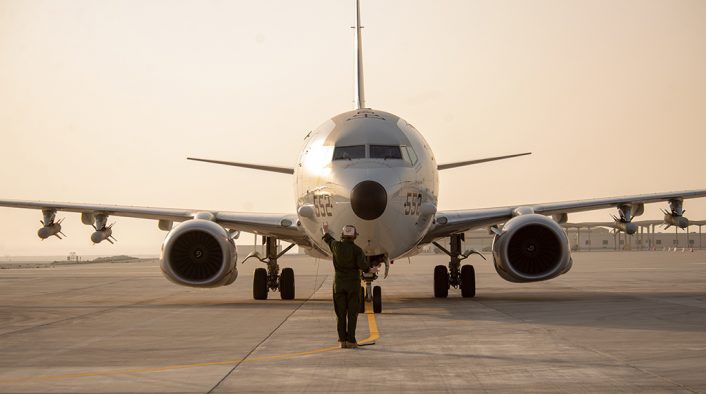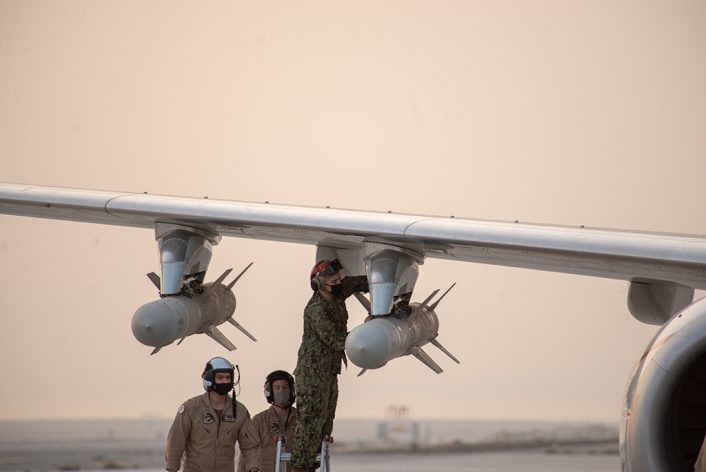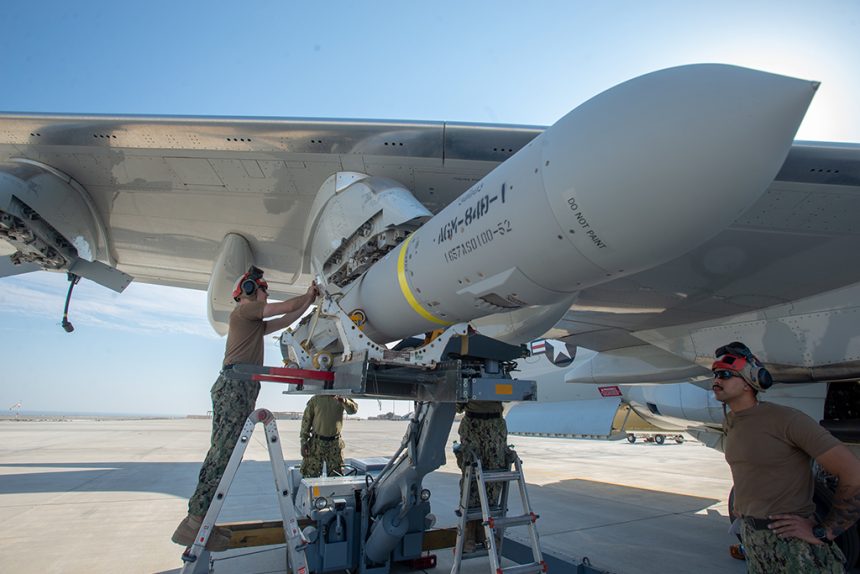The P-8A Poseidon aircraft of VP-8 carry AGM-84D Harpoon missiles in latest images released by the U.S. Navy.
The U.S. Navy P-8A Poseidon aircraft have started flying missions in the U.S. 5th Fleet AOR (Area of Operations) carrying AGM-84D Harpoon missiles. Images just released by the naval service through the DVIDS network show sailors assigned to the “Fighting Tigers” of Patrol Squadron 8, deployed with Commander, Task Force (CTF) 57, performing preflight checks on AGM-84 harpoon missiles carried by a P-8A of VP-8 ahead of a mission in the U.S. 5th Fleet area of operations (that encompasses the Persian Gulf, Red Sea, Arabian Sea, and parts of the Indian Ocean) on Jan. 15-16, 2021.
While the location where the images were taken has not been disclosed, it seems quite likely that the P-8A was being serviced at its usual deployment base in Manama, Bahrain, where P-3 Orion and Poseidon aircraft supporting CTF-57 are usually based.
CTF-57 is the maritime patrol and reconnaissance aircraft Task Force for the U.S. 5th Fleet, Naval Forces Central Command, and Combined Maritime Forces. CTF-57 aircraft conduct missions in support of maritime operations to ensure stability, security, and the free flow of commerce in the Central Command area of responsibility, which connects the Mediterranean and Pacific through the Western Indian Ocean.

The AGM-84D Harpoon is an anti-ship missile that complements the Mk 54 air-launched lightweight torpedo, used for ASW (Anti-Submarine Warfare) mission. It’s obviously not the first time the Poseidon is spotted carrying this kind of weapon, although it’s the first time we see this armament on a P-8 deployed to the Persian Gulf area.
0124Z#USN 🇺🇸 P-8A Poseidon #ISR #ASW #ASuW
Over Persian Gulf.#AE6823 pic.twitter.com/v6Bmz1foYI
— Aleph א ☕ (@no_itsmyturn) February 11, 2021
We don’t know where the Poseidon with its live Harpoon payload flew after the shots were taken. The P-8s are a common presence in the Persian Gulf area, where they have often been tracked by means of their Mode-S transponders. However, they also extend their patrols to the Gulf of Oman and to the Horn of Africa, where they support anti-piracy operations.
A @usairforce KC-135 Stratotanker refuels a @USNavy P-8A Poseidon in the @CENTCOM AOR. KC-10 and KC-135 tankers provide U.S. and allied aircraft unlimited range, making it possible to be anywhere in hours.#TogetherWeDeliver @AirNatlGuard @AirMobilityCmd @USAFCENT pic.twitter.com/x1n6sAcWBC
— USTRANSCOM (@US_TRANSCOM) February 16, 2021
Still, considered when the image was taken (mid January, a period of intense Iranian naval activity in the Persian Gulf and Strait of Hormuz), it seems more likely that that kind of weaponry was loaded to deter any kind of attack against U.S. Navy warships and commercial traffic in the area. In fact, the U.S. has maintained a significant naval presence in region consistently since May 2019, as a hedge against Iran. Since then, a carrier strike group has been positioned in the Gulf round-the-clock, with few gaps in presence. At the beginning of February, USS Makin Island Amphibious Ready Group and embarked Marine Medium Tiltrotor Squadron 164 (Reinforced), 15th Marine Expeditionary Unit (with its F-35Bs) transited the Strait of Hormuz to operate in the Persian Gulf replacing USS Nimitz, after supporting Operation Octave Quartz off the coast of Somalia.

P-8As are maritime patrol aircraft but even when they are not loaded with anti-ship missiles or toperdos, they carry a wide array of sensors that give the aircraft the ability to operate in the ISR (Intelligence Surveillance Reconnaissance) battlespace. Here’s what we have already explained in a previous article here at The Aviationist:
[…] the P-8s are multi-mission platforms that can gather valuable intelligence using a wide array of sensors. Among these, an Advanced Airborne Sensor (a dual-sided AESA radar that can offer 360-degree scanning on targets on land or coastal areas, and which has potential applications as a jamming or even cyberwarfare platform according to Northrop Grumman); an APY-10 multi-mode synthetic aperture radar; an MX-20 electro-optical/infrared turret for shorter-range search; and an ALQ-240 Electronic Support Measure (ESM) suite, able to geo-locate and track enemy radar emitters. Moreover, all sensors contribute to a single fused tactical situation display, which is then shared over both military standard and internet protocol data links, allowing for seamless delivery of information amongst U.S. and coalition forces.
In that respect, the P-8A Poseidon represents a huge leap forward if compared to the P-3 Orion. For instance, the externally mounted AP/ANY-10 MTI imaging radar system (upgrade from the P-3’s Littoral Surveillance Radar System – LSRS), adds both an overland and maritime MTI capability approaching the fidelity provided by the US Joint Surveillance and Target Attack Radar System (JSTARS). The significant difference with the more modern P-3s is, in particular, in the P-8’s ability to rapidly exchange and share information internally among the crew and externally among joint partners.
H/T Ryan Chan for the heads-up!









